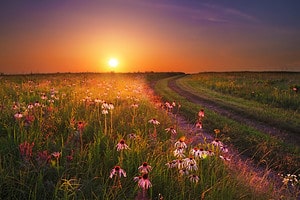White annual flowers are the perfect way to add a touch of elegance and romantic style to your garden. They are a great way to add interest to cottage gardens, cut gardens, and beds for evening interest. These flowers look stunning next to different foliage, from dark green to silvery gray.
White flowers are always a favorite for wedding bouquets and garden wedding backdrops. The color white represents innocence and new beginnings. There are a variety of beautiful white annuals to choose from, so you’re sure to find the perfect bloom for your space. Discover our list below of 10 white annual flowers that bring a touch of grandeur to pretty pots and garden beds.

1. Bacopa
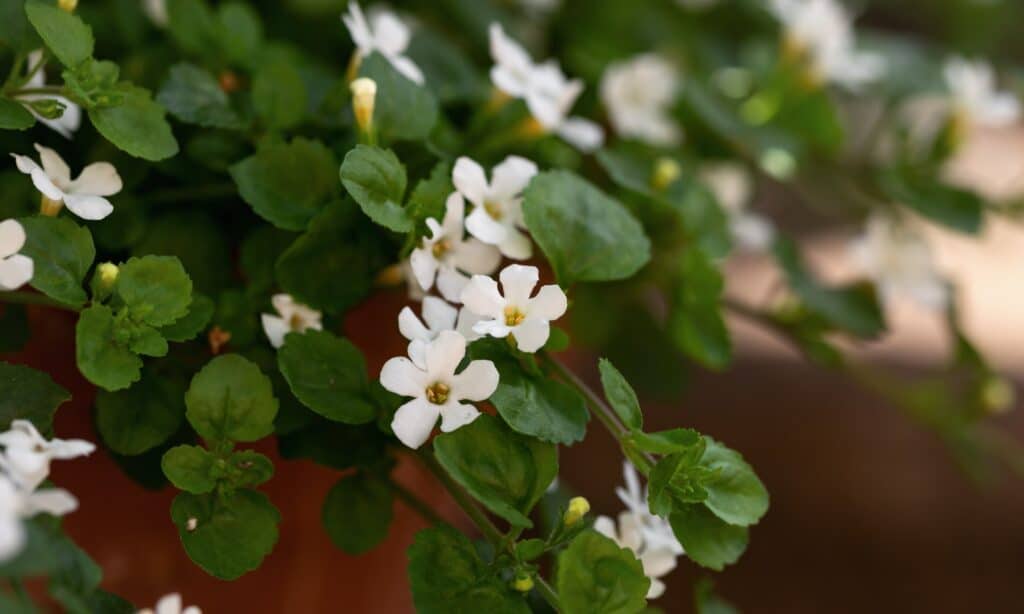
White bacopa plants perform best in full sun but can tolerate partial shade.
©iStock.com/Maksims Grigorjevs
Botanical name: Sutera cordata
Common names: Ornamental bacopa, bacopa, terrestrial bacopa
USDA hardiness zones: 9 to 11
Sun exposure: Full sun to partial shade
Mature size: Up to 12 inches tall, 36 inches wide
Bloom time: Spring through fall
Flower colors: White, blue, lavender
White bacopa is a dainty perennial often grown as an annual in many hardiness zones. One appeal of bacopa is its many small white blooms atop green-gold foliage. This delicate white annual flower with round, flat blooms is perfect for ground cover planting.
Your white bacopa plants perform best in full sun but can tolerate partial shade. However, bacopa flowers need relief in high heat. Thus, give your bocopas extra shade on the year’s hottest days. Or buy newer cultivars of white bacopas that might be more heat-tolerant.
- Watering needs: Keep well-drained soil moist but not soggy.
- Maintenance: No deadheading is necessary, but add a balanced fertilizer to bacopa plants once or twice a month.
- Garden pests: Aphids, spider mites, thrips, and whiteflies are all attracted to these white annual flowers.
- Common diseases: Overwatering bacopa causes root rot, stem rot, and powdery mildew. If overwatered, loads of little bacopa blooms will fall off the plants.
2. Begonia
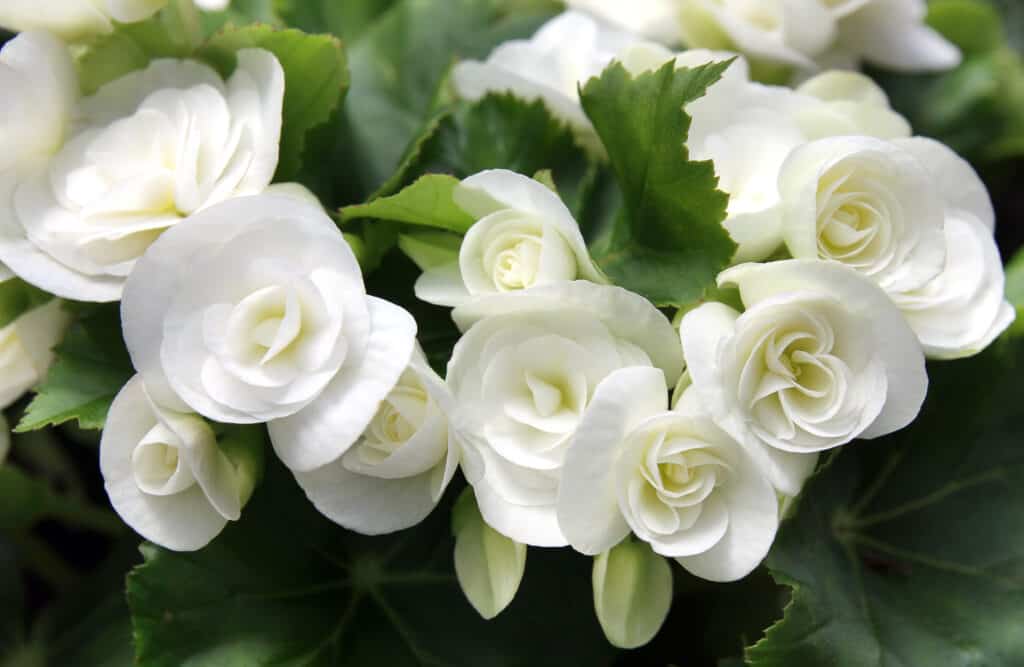
Begonia’s flowers grow up to 8 inches across and really stand out against the plant’s dark-green foliate.
©Opachevsky Irina/Shutterstock.com
Botanical name: Begonia x tuberhybridia ‘Roseform White’
Common names: Double begonia, tuberous begonia
USDA hardiness zones: 9 to 11
Sun exposure: Partial sun
Mature size: Up to 2 feet tall, 1 foot wide
Bloom time: Summer to fall
Flower colors: White
The double begonia cultivar ‘Roseform White’ is a showy white annual flower. Its pure white rose-shaped blooms will dazzle as bedding plants or in pots and containers. In addition, this begonia’s flowers grow up to 8 inches across and really stand out against the plant’s dark-green foliate.
Though they look so fancy you’d think they need lots of care, ‘Roseform White’ begonias are easy to grow. Plus, this white annual flower’s tuber can be overwintered to grow again by storing it in a cool, dry place.
- Watering needs: Regularly water the well-draining soil every 2-3 days or more in hotter weather.
- Maintenance: Begonias like neutral or slightly acidic soil with good circulation. Fertilize begonia plants every two weeks with a fertilizer high in nitrogen.
- Garden pests: Double begonias like ‘Roseform White’ might be bothered by mealy bugs, snails, spider mites, and thrips.
- Common diseases: Begonias could get root rot, powdery mildew, and leaf spot.
3. Daisy
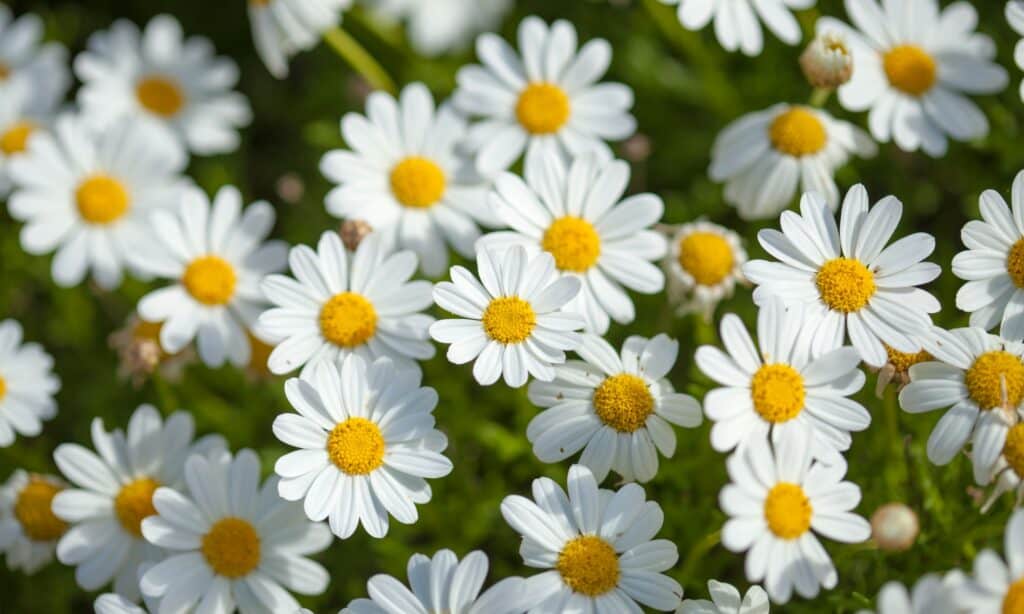
Daisies make excellent cut flowers for bouquets and arrangements.
©iStock.com/tamara_kulikova
Botanical name: Bellis perennis
Common names: English daisy, bruisewort, lawn daisy
USDA hardiness zones: 4 to 8
Sun exposure: Full sun to partial shade
Mature size: 6 inches tall and 8 inches wide
Bloom time: Spring to summer (peaks in mid-spring)
Flower colors: White, blue, pink, red
Daisies are well-known and loved for their small, cheery blooms worldwide. And the English daisy is a perennial that can survive freezing winters and scorching summers. In fact, the English daisy is sometimes called a weed because it’s so difficult to get rid of in gardens and lawns!
While daisies might not be a favorite flower for some gardeners, there’s no denying their beauty. This small white annual flower has a yellow center with long, thin petals ranging in color from white to red. Daisies make excellent cut flowers for bouquets and arrangements.
- Watering needs: Well-drained, moist soil is best. Note that English daisies are not drought-tolerant.
- Maintenance: Deadhead the spent blooms regularly to keep your daisies looking their best. You can also fertilize daisies once a month with a water-soluble fertilizer.
- Garden pests: Whiteflies, leafminers, aphids, and mites love to nibble on daisies.
- Common diseases: Daisies could develop rust fungus, powdery mildew, and leaf spot.
4. Echinacea
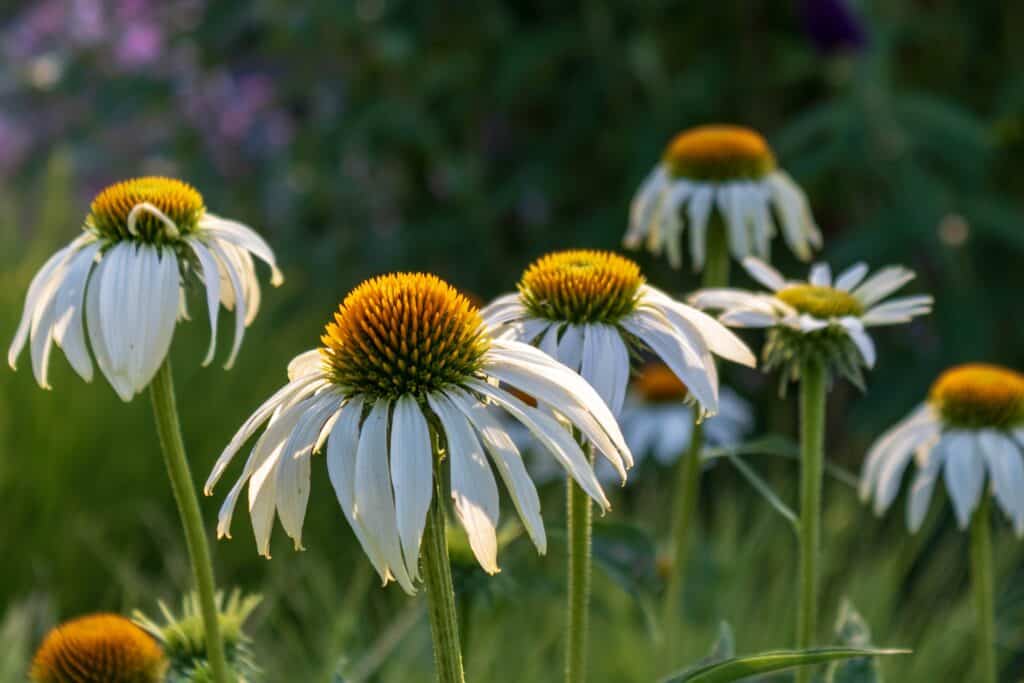
White echinacea plants like ‘Fragrant Angel’ add elegant accents to cut flower gardens.
©Lillusion/Shutterstock.com
Botanical name: Echinacea purpurea ‘Fragrant Angel’
Common names: Echinacea, white coneflower, Fragrant Angel echinacea
USDA hardiness zones: 4 to 9
Sun exposure: Full sun is best
Mature size: Up to 3 feet tall, 24 inches wide
Bloom time: Summer to fall
Flower colors: White
The echinacea cultivar ‘Fragrant Angel’ has big 5-inch flowers with narrow white petals (called ray petals) and an orange center. Also, this white annual flower has a double row of petals for extra lush blooms.
White echinacea plants like ‘Fragrant Angel’ add elegant accents to cut flower gardens. This plant is also a garden favorite because it attracts pollinators like bees, butterflies, and hummingbirds.
- Watering needs: Echinacea has relatively low to average water needs. This plant is drought-tolerant and needs watering once or twice a week.
- Maintenance: Deadhead spent echinacea blooms and cut back the stems to encourage another flowering.
- Garden pests: Echinacea plants might fall prey to aphids, Japanese beetles, and sweet potato whiteflies.
- Common diseases: Echinacea flowers are susceptible to Botrytis blight, leaf spot, root rot, and crown rot.
5. Impatiens
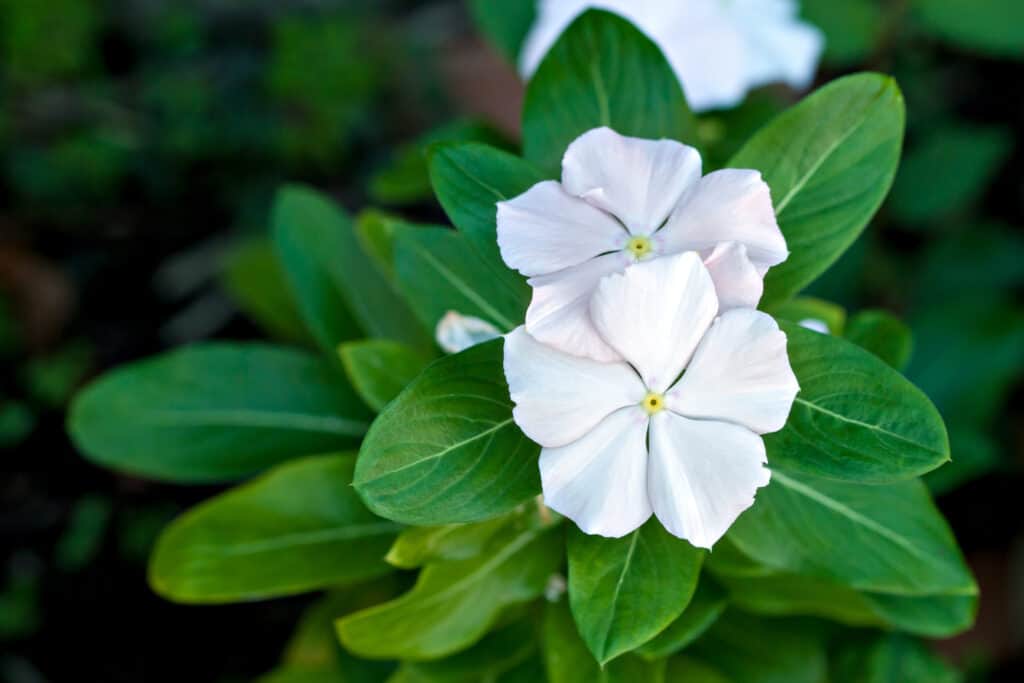
Impatiens are easy to care for, making them a good flower choice for gardening novices.
©Tikta Alik/Shutterstock.com
Botanical name: Impatiens walleriana ‘Rockapulco White’
Common names: Busy lizzy, touch-me-not
USDA hardiness zones: 2 to 11
Sun exposure: Partial sun to shade
Mature size: Up to 24 inches tall and wide
Bloom time: Spring through fall
Flower colors: White
With flower shapes similar to roses, the ‘Rockapulco White’ variety of impatiens is the epitome of garden elegance. This showy cultivar has pristine white and fluffy double blooms. Like all impatiens plants, ‘Rockapulco White’ grows well in the shade.
This variety of white impatiens is a stunner in container gardens, growing in a rounded mound shape. And impatiens are easy to care for, so they make a good flower choice for gardening novices.
- Watering needs: They need well-drained soil kept slightly moist but don’t do well when overwatered.
- Maintenance: Impatiens are self-cleaning, so you don’t need to deadhead. However, you may want to fertilize impatiens monthly for the best flowering performance.
- Garden pests: Aphids, vine weevils, and spider mites are common pests for impatiens.
- Common diseases: Impatiens are susceptible to leaf spot, powdery mildew, and root rot.
6. Moonflower
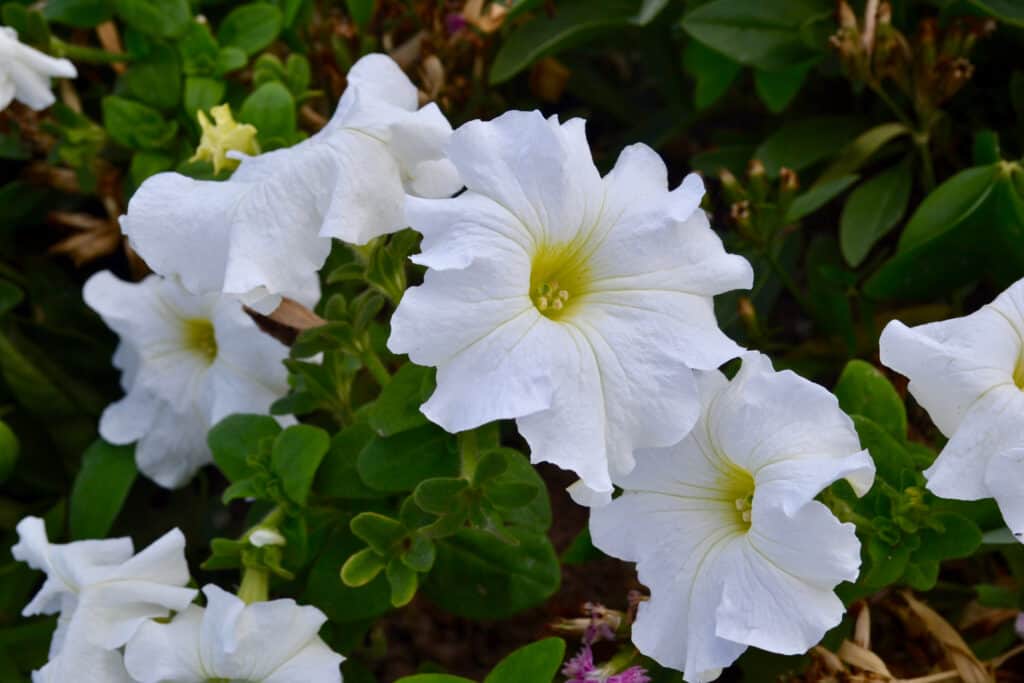
Moonflower blooms grow up to 6 inches across and have a sweet scent.
©Khadijahanifa/Shutterstock.com
Botanical name: Ipomoea alba
Common names: Moonflower, tropical white morning glory, moon vine, Belle de Nuit
USDA hardiness zones: 9 to 12
Sun exposure: Full sun
Mature size: Up to 15 tall, 6 feet long
Bloom time: Summer to fall
Flower colors: White
The moonflower is a fast-growing climbing vine that produces large, fragrant flowers. If you’re looking for a huge and showy white annual flower, the moonflower makes a great choice! In addition, its trumpet-shaped petals only open at night and then close again during the day. For this reason, moonflower vines grow well next to patios or decks to enjoy their blooms and fragrance in the evening.
Moonflower blooms grow up to 6 inches across and have a sweet scent. However, the impressive-looking moonflower will spread quickly to other areas of your garden if left to self-seed. Yes, it grows quickly! But it’s also such a fun surprise when the blooms open at dusk that you’ll want white moonflowers growing everywhere.
This striking annual plant is also perfect for containers and hanging baskets where you want them to trail down the sides.
- Watering needs: Moonflower vines love evenly damp and well-drained soil that’s not overwatered.
- Maintenance: To successfully grow moonflowers, you’ll need to provide something for them to climb, like a trellis, pergola, fence, or gazebo. But you won’t need to fertilize them because fertilized soil makes the moonflower produce fewer blooms.
- Garden pests: Moonflower vines don’t have many pests but could fall prey to tomato hornworms.
- Common diseases: If the humidity is high where you live, your moonflower vines are susceptible to a bacterial infection called black rot.
7. Petunia
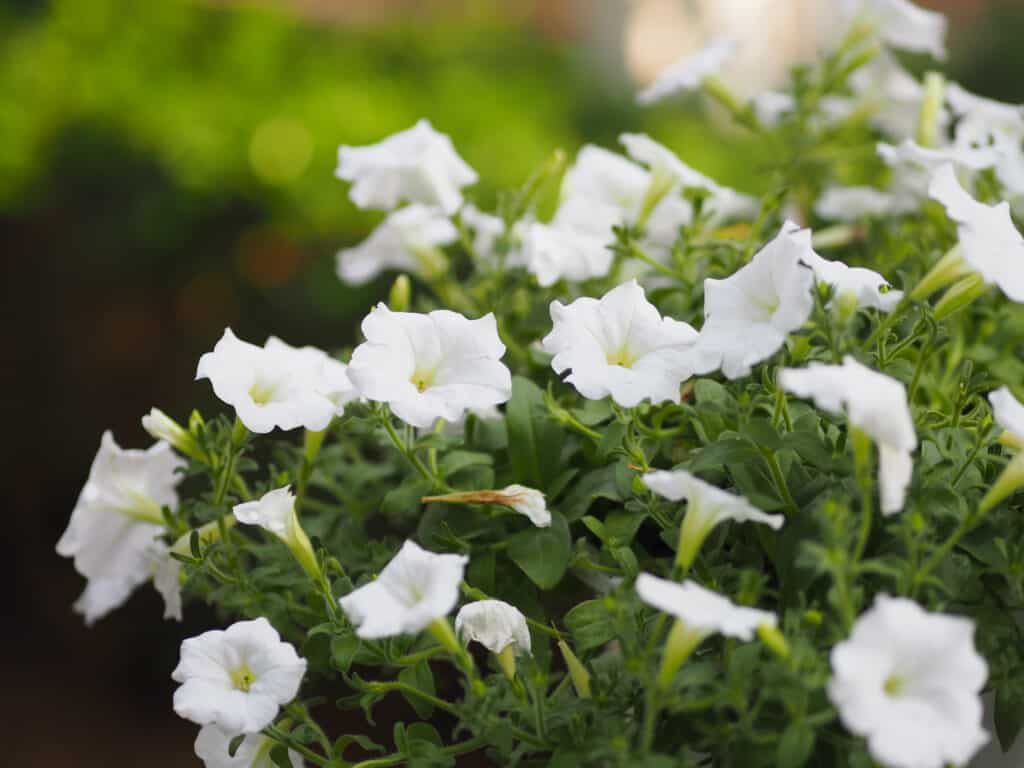
Petunia blooms are trumpet-shaped on top of plants that grow in rounded mounds.
©pakn/Shutterstock.com
Botanical name: Petunia x hybrida ‘Easy Wave White’
Common names: Petunia, trailing petunia, Easy Wave White petunia
USDA hardiness zones: 2 to 11
Sun exposure: Full sun to partial shade
Mature size: Up to 1 foot tall, 3 feet wide
Bloom time: Spring through fall
Flower colors: White
Petunias in white make picturesque ground cover flowers and look lovely when planted en masse. A popular white petunia cultivar called ‘Easy Wave White’ has bright white flowers with light green centers. So look for these soft and delicate flowers to bring a sweet sophistication to your garden.
If you’re not familiar with petunias yet, know that these annual flowers come in lots of colors and are super easy to grow. Petunia blooms are trumpet-shaped on top of plants that grow in rounded mounds. However, petunias also love to spread! So if you don’t cut them back, your petunias will trail down pots or across beds as their stems get leggier over time.
- Watering needs: Keep well-drained soil slightly moist but not overwatered.
- Maintenance: Petunias love humus-rich soil, fertilized with a dark compost full of plant nutrients.
- Garden pests: Watch for slugs, aphids, and snails that might attack petunias.
- Common diseases: Petunias are susceptible to root rot and grey mold.
8. Snapdragon
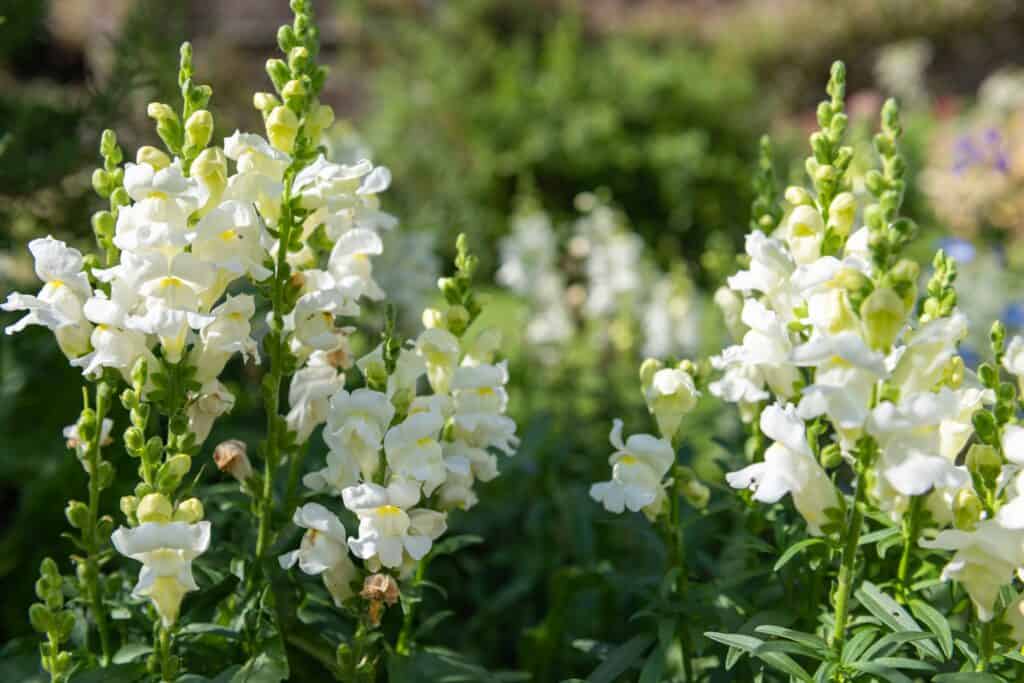
The snapdragon plant grows tiny flowers along tall stems that often need support to prevent them from flopping over.
©Tom Meaker/Shutterstock.com
Botanical name: Angelonia angustifolia hybrid ‘Angelface White’
Common names: snapdragon, summer snapdragon, Angelface White snapdragon
USDA hardiness zones: 10 to 11
Sun exposure: Full sun
Mature size: up to 36 inches tall, 20 inches wide
Bloom time: Spring to fall
Flower colors: White
Tall and showy snapdragons come in many colors, including pink, purple, red, yellow, and white. However, there’s something extra magical about the white ones for cottage gardens and cut flower beds. The ‘Angelface White’ snapdragon variety is a drought-tolerant beauty that blooms all season. Plus, most colors of snapdragons have the added benefit of smelling like grape soda!
The fragrant snapdragon plant grows its tiny flowers along tall stems that often need support to prevent them from flopping over. So you might want to plant these white annual flowers along a fence, near a trellis, or in the back of a garden bed where they can really stand out.
Snapdragons have pretty jaw-like blooms that open and close when squeezed. These blooms are how they got the name snapdragons!
- Watering needs: The lovely snapdragon has low water needs, making growing even easier. Water snapdragons once a week unless wilting indicates that your plants need more. Avoid watering snapdragon plants from the spike tops. Watering at the crown (soil level) of the plant is best.
- Maintenance: No deadheading is needed for snapdragons as they are self-cleaning plants. Giving them some fertilizer once or twice a month will help your plants stay vibrant.
- Garden pests: Aphids, whiteflies, and mealybugs might munch on snapdragons now and then.
- Common diseases: Snapdragons could develop root rot, crown rot, powdery mildew, and leaf spot.
9. Sweet Alyssum
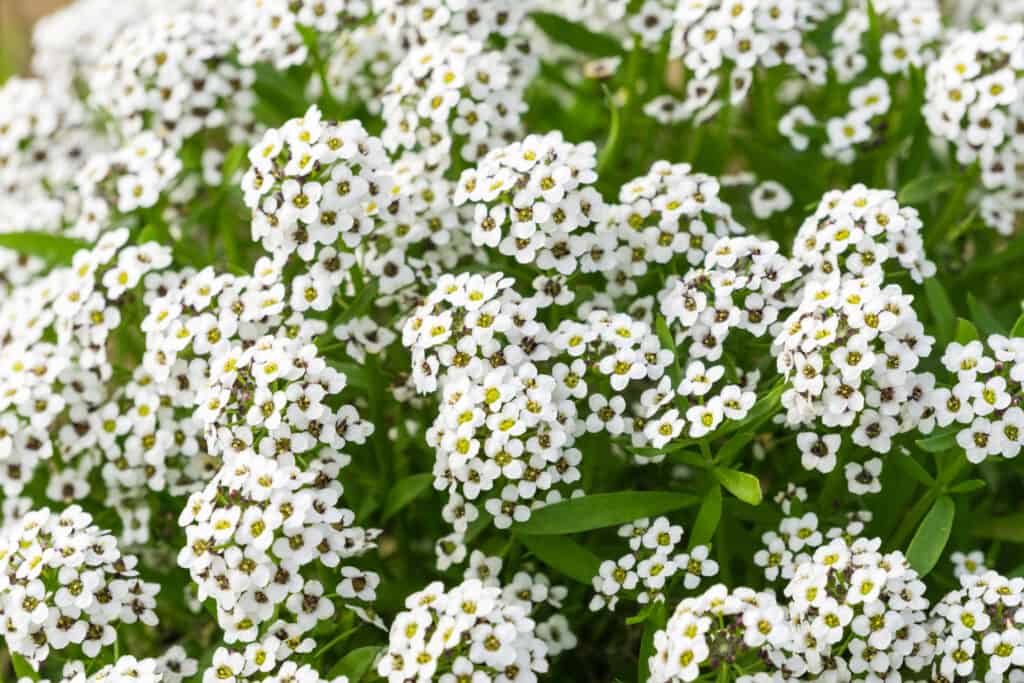
Sweet alyssum has a lovely fragrance that attracts bees, butterflies, and other pollinators.
©iStock.com/Sundry Photography
Botanical name: Lobularia maritima
Common names: Sweet alyssum, alyssum, bunny tails
USDA hardiness zones: 2 to 11
Sun exposure: full or partial sun
Mature size: Up to 8 inches tall, 12 inches wide
Bloom time: Spring to summer
Flower colors: White, peach, lavender, pink
Sweet alyssum is a low-growing annual flower that produces masses of tiny blooms. The flowers are usually white or very light pink. Sweet alyssum has a lovely fragrance that attracts bees, butterflies, and other pollinators to your garden beds and containers. This white annual flower is often planted as ground cover or in rock gardens.
This dense plant full of tiny white flowers is very easy to grow from seed. For ground cover, simply scatter some sweet alyssum seeds on top of the soil where you want them to bloom. Then lightly rake or press the seeds into the soil. Keep the soil moist until the new seeds germinate, and water as needed.
- Watering needs: Sweet alyssums don’t need much maintenance, including only about an inch of water per week. However, hotter growing zones may require more frequent watering.
- Maintenance: Keep sweet alyssum plants looking healthy with regular fertilizer applications 1-2 times per month. Though fertilizing isn’t necessary to keep them alive and blooming, alyssums thrive with occasional boosts of plant nutrients. And if you want them to bloom a second time during the growing season, cut them back by half after their first bloom.
- Garden pests: Sweet alyssum might be attacked by aphids but perhaps not for long. Fortunately, sweet alyssum plants also attract insects that feed on the bugs that could harm them. For example, sweet alyssum attracts parasitic or parasitoid wasps that eat aphids and mealy bugs. Sweet alyssum is so valuable for the longevity of parasitoid wasps that many gardeners place it next to other plants to save them from various garden pests.
- Common diseases: Root rot and downy mildew are a couple of fungal conditions that might plague your sweet alyssum plants.
10. Zinnia
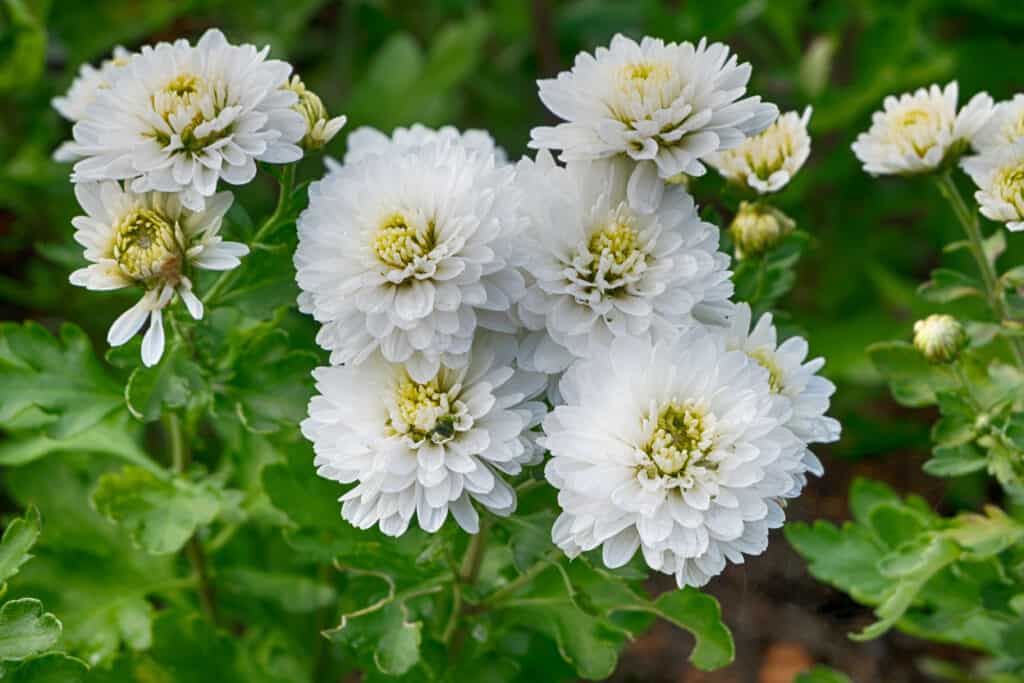
Zinnias are easy to grow and make excellent cut flowers.
©Thamrong Chunivarawat/Shutterstock.com
Botanical name: Zinnia elegans ‘Polar Bear‘
Common names: Zinnia, tall garden zinnia, Polar Bear zinnia
USDA hardiness zones: 2 to 11
Sun exposure: Full sun
Mature size: Up to 3 feet tall, 24 inches wide
Bloom time: Summer through fall
Flower colors: Qhite
The zinnia cultivar ‘Polar Bear’ has big white blooms on tall stems. Zinnias are dramatic annual flowers that come in a wide range of colors, including pink, purple, red, white, and yellow. They are easy to grow and make excellent cut flowers. Plus, zinnias attract butterflies and hummingbirds to pollinate your garden!
‘Polar Bear’ zinnias have bright white petals on double blooms that are truly impressive to see. And this elegant zinnia is also sturdy and blooms for a long time. And it lasts a long time in bouquets and vase arrangements.
- Watering needs: It’s best to keep a zinnia’s well-draining soil moist by watering it 2-3 times a week. However, don’t overwater, or the plant might get root rot.
- Maintenance: Zinnias like humus-rich soil from a humus fertilizer. Also, zinnias need plenty of air circulation, so don’t overcrowd them in a garden pot.
- Garden pests: Zinnias attract whiteflies, aphids, and spider mites.
- Common diseases: Your zinnia plants could develop root rot and powdery mildew.
Summary of 10 White Annual Flowers
Here’s a recap of the 10 wonderful white annual flowers that we took a look at.
| Number | Flower | Botanical name | USDA hardiness zones | Bloom time |
|---|---|---|---|---|
| 1 | Bacopa | Sutera cordata | 9 to 11 | Spring through fall |
| 2 | Begonia | Begonia x tuberhybridia ‘Roseform White’ | 9 to 11 | Summer to fall |
| 3 | Daisy | Bellis perennis | 4 to 8 | Spring to summer (peaks in mid-spring) |
| 4 | Echinacea | Echinacea purpurea ‘Fragrant Angel’ | 4 to 9 | Summer to fall |
| 5 | Impatiens | Impatiens walleriana ‘Rockapulco White’ | 2 to 11 | Spring through fall |
| 6 | Moonflower | Ipomoea alba | 9 to 12 | Summer to fall |
| 7 | Petunia | Petunia x hybrida ‘Easy Wave White’ | 2 to 11 | Spring through fall |
| 8 | Snapdragon | Angelonia angustifolia hybrid ‘Angelface White’ | 10 to 11 | Spring to fall |
| 9 | Sweet Alyssum | Lobularia maritima | 2 to 11 | Spring to summer |
| 10 | Zinnia | Zinnia elegans ‘Polar Bear’ | 2 to 11 | Summer through fall |
White Annual Flowers Make Garden Elegance Easy to Achieve
Try white annual flowers if you’re looking for a classic, romantic look of elegance in the garden! Beautiful white flowers are perfect for filling in gaps in your garden beds or adding a touch of sophistication to your porch or patio. Many of the white annual flowers we suggested also have sweet fragrances and evening interest.
The photo featured at the top of this post is © pakn/Shutterstock.com
Sources
- The Huntington Library, Art Museum, and Botanical Gardens, Available here: https://huntington.org/verso/ranch-plant-profile-sweet-alyssum
- Proven Winners North America LLC, Available here: https://www.provenwinners.com/learn/top-ten-lists/top-10-wonderful-white-annuals
- CityFlowersIndia, Available here: https://www.cityflowers.co.in/blogs/news/white-flowers-meaning-and-history#:~:text=The%20composure%20and%20purity%20of,the%20begining%20of%20flowers%20history.
Thank you for reading! Have some feedback for us? Contact the AZ Animals editorial team.




